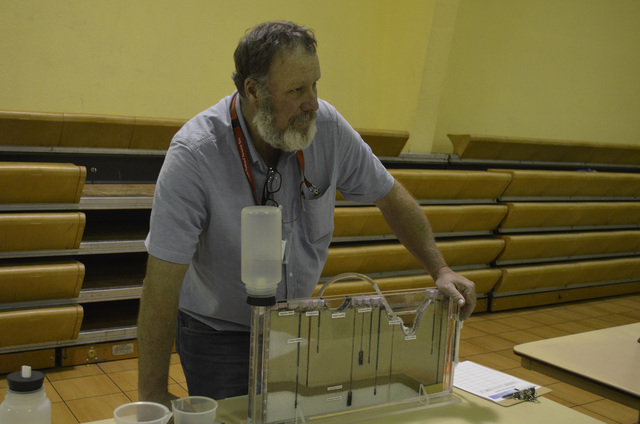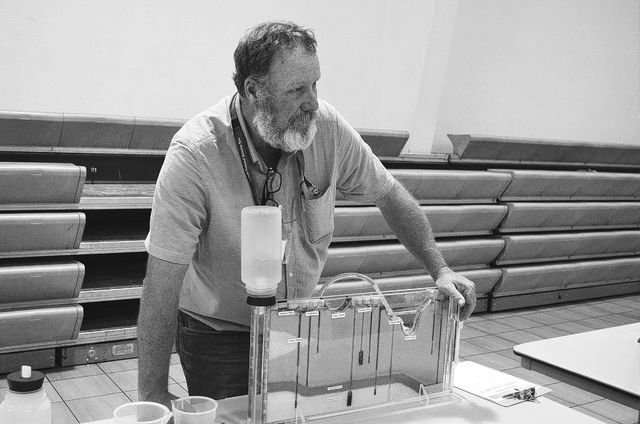The seventh Annual Groundwater Open House takes place in Amargosa
A score of state and county scientists sought to assure Nye County residents that their water hasnt been affected by underground nuclear testing at the Nevada National Security Site.
The seventh Annual Groundwater Open House took place on Tuesday at the Amargosa Community Center in Amargosa Valley. A number of scientists at the event presented information about ongoing water testing at the site.
As part of the U.S. Department of Energys $70 million environmental management program, officials conduct water well testing at the Nevada National Security Site every year.
Scott Wade, assistant manager for environmental management at the NNNS Nevada field office, said the groundwater from the test site generally flows toward Beatty and Amargosa Valley.
Weve really found nothing new per se from groundwater flow or transport (during last year). Nothing that tells us all the water was going a different direction or was it going faster. What weve actually done is just added to the amount of information we had, Wade said.
Over 900 nuclear tests were conducted in Nevada between 1951 and 1992 after the Atomic Energy Commission designated a big portion of land 65 miles northwest of Las Vegas for atmospheric atomic testing. The Nevada National Security Site is one of 12 sites where the DOE still does work.
In August 2015, Nye County received a five-year $1.27 million grant from the DOE for a Tritium Groundwater Monitoring Program that covered the cost of the procedure.
The ten wells sampled Amargosa Valley and Beatty under the program in December showed undetectable levels of tritium, according to the recent lab results.
Tritium is a soluble contaminant that moves with the groundwater at the rate of the groundwater flow. It has a 12.2-year life span and is used as the tracer for other contaminants and is relatively easy to detect.
All sampled wells had the detection limits of 278 or 313 picocuries per liter, according to the report. The Safe Water Drinking Act limit for tritium in drinking water is 20,000 picocuries per liter.
Wade said studies conducted as part of the environmental management program also look for other isotopes.
When theres a nuclear weapons test, one of the first indicators is mobilization of tritium from the test, he said. So we study and look for tritium in our groundwater samples because we found it to be most mobile in groundwater. But we also look for a whole bunch of other radio isotopes.
Theres no flow area that goes to Pahrump, Wade added.
We find that because of geologic structures, there isnt really a risk for any test site groundwater flow and transport going to the city of Pahrump. Its just hydrologically disconnected, he said.
Bill Wilborn, director for UGTA sub-projects, said that some mistakenly think that the tests have contaminated the aquifer and the water flows to the Death Valley National Park or Las Vegas.
When it relates to Las Vegas, its never going to get there, its a completely different watershed. As far as reaching Death Valley or Amargosa Valley or Beatty, its going to take a long period of time, he said.
Officials previously said tritium was detected in one of the wells west of Pahute Mesa, where 85 nuclear tests were conducted between 1965 and 1992.
The well is located on the Nevada Test and Training Range, 2,350 feet west of the NNSS boundary, and approximately 23 miles northwest of Beatty.
The tritium level in the well was 10,600 picocuries per liter in 2009, which is below the Safe Water Drinking Acts limit.
At some point in the far future we are going to address any contamination that comes off the site toward any public receptors, but at this point, we only see the small amounts coming off the test site boundary and they are below safe water drinking standards, Wilborn said.
Tritium flows more readily with water but it also doesnt live as long, Wilborn said.
After 200 years, all the tritium is going to die off. Some of the heavier, longer-lived radionuclides that are in these tests will take much longer to get through, he said.
Theres a lot of uncertainty that goes with that, he added. And I dont want to give anybody the impression that we know exactly what this water is doing. We only have a conceptualization of exactly whats happening and then we test that conceptualization on data we collect.
















